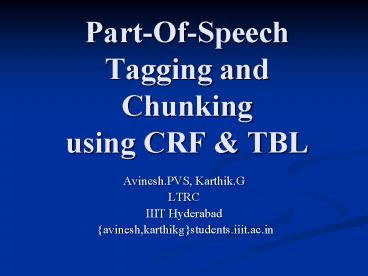PartOfSpeech Tagging and Chunking using CRF - PowerPoint PPT Presentation
1 / 22
Title:
PartOfSpeech Tagging and Chunking using CRF
Description:
... model is used for Telugu, Hindi and Bengali except for variations in the window size i.e. for Hindi, Bengali and Telugu we used a window size of 6, 6 and 4 ... – PowerPoint PPT presentation
Number of Views:308
Avg rating:3.0/5.0
Title: PartOfSpeech Tagging and Chunking using CRF
1
Part-Of-Speech Tagging and Chunking using CRF
TBL
- Avinesh.PVS, Karthik.G
- LTRC
- IIIT Hyderabad
- avinesh,karthikgstudents.iiit.ac.in
2
Outline
- 1.Introduction
- 2.Background
- 3.Architecture of the System
- 4.Experiments
- 5.Conclusion
3
Introduction
- POS-Tagging
- It is the process of assigning the part of
speech tag to the NL text based on both its
definition and its context. - Uses
- Parsing of sentences, MT, IR, Word Sense
disambiguation, Speech synthesis etc. - Methods
- 1. Statistical Approach
- 2. Rule Based
4
Cont..
- Chunking or Shallow Parsing
- It is the task of identifying and segmenting
the text - into syntactically correlated word groups.
- Ex
- NP He VP reckons NP the current
account deficit VP will narrow PP to NP
only 1.8 billion PP in NP September .
5
Background
- Lots of work has been done using various machine
learning approaches like - HMMs
- MEMMs
- CRFs
- TBL etc
- for English and other European Languages.
6
- Drawbacks For Indian Languages
- These techniques dont work well when small
amount of tagged data is used to estimate the
parameters. - Free word order.
7
So what to do???
- Add more information
- Morphological Information
- Root, affixes
- Length of the Word
- Adverbs, Post-positions 2-3 chars long.
- Contextual and Lexical Rules
8
- OUR APPROACH
9
POS-Tagger
Training Corpus
Features
Training Corpus
TBL (Building Rules)
CRFs Training
Model
CRFs Testing
Test Corpus
Lexical Contextual Rules
Pruning CRF output using TBL Rules
Final Output
10
Chunker
HMM Based Chunk Boundary Identification
Training Corpus
CRFs Training
Features
Model
CRFs Testing
Test Corpus
Final Output
11
Experiments
- Pos-Tagging
- a) Features for CRF
- 1) Basic Template of the combination of
surrounding words have been used. - i.e. window size of 2,4, and 6 are tried
with all possible combinations. - (4 was best for Telugu)
- Ex Window size of 2 W-1,cW,W1
- Window size of 4 W-2, W-1, cW, W1, W2
- Window size of 6 W-3, W-2, W-1, cW, W1,
W2,W3 - cW Current word
- W-1 Previous word, W-2 Previous 2nd
Word, W-3 Previous 3rd word - W1 Next Word, W2 Next 2nd Word,
W3 Next 3rd word - Accuracy 62.89 (5193 test data)
12
- 2) n-Suffix information
- This feature consists of the last, last
2,last 3 and last 4 chars of a word. (Here the
suffix mean statistical suffix not the linguistic
suffix) - Reason
- Due to the agglutinative nature of Telugu
considering the suffixes increases the accuracy.
- Ex ivvalsociMdi (had to give) VRB
- ravalsociMdi (had to come) VRB
- Accuracy 73.45
13
- 3) n-Preffix information
- This feature consists of the first, first 2,
first 3, and so on up to first 7 chars of the
words. ( prefix means statistical prefix not the
linguistic prefix) - Reason
- Usually the vibakthis get added to nouns.
- puswakAlalo (in the books) NN
- puswakAmnu (the book) NN
- Accuracy 75.35
14
- 4)Word Length
- All the words with length lt3 are tagged as
Less and the rest are tagged as More. - Reason
- This is to account large number of
functional words in Indian Language. - Accuracy 76.23
15
- 5) Morph Root Expected Tags
- Root word and the best three expected lexical
categories are extracted using the morphological
analyzer and are added as feature. - Reason
- It is similar to the concept of the prefix and
suffix. But here the root is extracted using the
Morph Analyzer. Expected tags can be used bind
the output of the tagger. - Accuracy 76.78
16
- b) Pruning
- Next step is pruning the output using the
rules generated by TBL i.e. the contextual and
the lexical rules. - Ex
- VJJ to VAUX when bigram is lo unne
- JJ to NN when next tag is PREP
- Accuracy 77.37
17
Tagging Errors
- Issues regarding the nouns/compound
nouns/adjectives. - NN ? NNP
- NNC ? NN
- NN ? JJ
- And Also,
- VRB ? VFM VFM ? VAUX etc
18
Experiments(chunking)
- 1) Chunk Boundary identification
- Initially we tried out HMM model for
identifying the chunk boundary . - First level
- pUrwi NVB B
- cesi VRB I
- aMxiMcamani VRB I
19
- 2) Chunk Labeling Using CRFs
- Features used in the CRF based approach
are - Word window of 4 W-2,W-1,cW,W1,W2
- Pos-tag window of 5 P-3,P-2,P-1,cP,P1,
P2 - We used the chunk boundary label as a feature.
- Second level
- pUrwi NVB B-VG
- cesi VRB I-VG
- aMxiMcamani VRB I-VG
20
Results
Fig.1 Results of the POS-Tagging
Fig.2 Chunking Results
The same model is used for Telugu, Hindi and
Bengali except for variations in the window size
i.e. for Hindi, Bengali and Telugu we used a
window size of 6, 6 and 4 respectively. Using
the Golden Standard tags the accuracy for Telugu
tagger was 90.65
21
Conclusion
- The best accuracies were achieved with the use
morphologically rich features like suffix, prefix
of information etc... coupled with various
efficient machine learning techniques - Sandhi Spliter could be used to improve furture.
- Eg
- 1 pAxaprohAlace (NN) pAxaprahArAliiu (NN) ce
(PREP) - 2 vAllumtAru(V) vAlylyu(NN)
uM-tAru(V)
22
Queries???
Thank You!!































